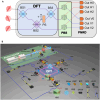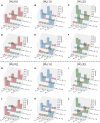Entangled measurement for W states
- PMID: 40938974
- PMCID: PMC12428927
- DOI: 10.1126/sciadv.adx4180
Entangled measurement for W states
Abstract
Entangled measurements are an indispensable tool for quantum information processing, such as Bell-state measurements in quantum teleportation and entanglement swapping. However, to date, the realization of entangled measurements has mainly focused on bipartite systems or Greenberger-Horne-Zeilinger (GHZ) states. Here, we demonstrate a practical scheme to realize entangled measurements for [Formula: see text] states. Thanks to the cyclic shift symmetry in the discrete Fourier transformation (DFT) of bosonic modes, the DFT measurement outcomes can be used to deterministically project multiqubit states onto [Formula: see text] states. Experimentally, we show that three-qubit [Formula: see text] state discrimination can be achieved by detecting the cyclic shift symmetry with a three-mode DFT optical circuit, yielding a measurement discrimination fidelity of 0.871 ± 0.039. Our experimental demonstration opens the door for the development of new quantum network protocols between multipartite systems.
Figures






References
-
- Pan J.-W., Chen Z.-B., Lu C.-Y., Weinfurter H., Zeilinger A., Żukowski M. Ż., Multiphoton entanglement and interferometry. Rev. Mod. Phys. 84, 777–838 (2012).
-
- Horodecki R., Horodecki P., Horodecki M., Horodecki K., Quantum entanglement. Rev. Mod. Phys. 81, 865–942 (2009).
-
- Cao S., Wu B., Chen F., Gong M., Wu Y., Ye Y., Zha C., Qian H., Ying C., Guo S., Zhu Q., Huang H.-L., Zhao Y., Li S., Wang S., Yu J., Fan D., Wu D., Su H., Deng H., Rong H., Li Y., Zhang K., Chung T.-H., Liang F., Lin J., Xu Y., Sun L., Guo C., Li N., Huo Y.-H., Peng C.-Z., Lu C.-Y., Yuan X., Zhu X., Pan J.-W., Generation of genuine entanglement up to 51 superconducting qubits. Nature 619, 738–742 (2023). - PubMed
-
- M. A. Nielsen, I. L. Chuang, Quantum computation and quantum information (Cambridge Univ. Press, 2010).
-
- Devitt S. J., Munro W. J., Nemoto K., Quantum error correction for beginners. Rep. Prog. Phys. 76, 076001 (2013). - PubMed
LinkOut - more resources
Full Text Sources

